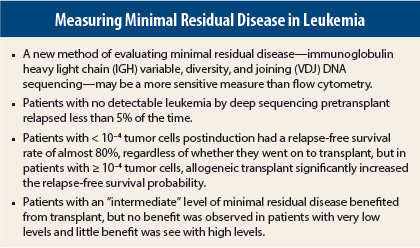In patients with acute leukemia, outcomes after hematopoietic stem cell transplantation are negatively impacted by the presence of minimal residual disease. However, transplant can prolong survival in patients with minimal residual disease after consolidation, according to two studies presented at the American Society of Hematology (ASH) Annual Meeting, and further discussed at the ASH Highlights of North America meeting in Miami.
The discussants were Nelson J. Chao, MD, MBA, Professor of Medicine and Immunology and Chief of the Division of Cellular Therapy at Duke University in Durham, North Carolina, and Matthew J. Wieduwilt, MD, PhD, Assistant Clinical Professor of Medicine at the University of California, San Diego, Moores Cancer Center in La Jolla.
Deep-Sequencing Studies in Children
A new method of evaluating for minimal residual disease—immunoglobulin heavy light chain (IGH) variable, diversity, and joining (VDJ) DNA sequencing—was used in the ASCT0431 study of the Children’s Oncology Group/Pediatric Blood and Marrow Transplant Consortium. The study involved patients aged 1 to 21 years undergoing stem cell transplantation for high-risk acute lymphoblastic leukemia (ALL) in first complete remission or second. Bone marrow samples were taken within 2 weeks of the preparative regimen and at 1 month, 3 months, and 9 to 12 months after transplant, and were subjected to IGH VDJ sequencing.
The initial analysis showed strong power to predict relapse and lower event-free survival by the presence of minimal residual disease > 0.1% in the bone marrow, both pre- and post-transplant. The new subanalysis tested whether the high level of sensitivity of minimal residual disease detection offered by deep sequencing would increase the predictive power.1
Deep-sequencing techniques were able to define clones in more than 95% of patients. Detection of blasts at any level, either pre- or post-transplant, predicted for worse event-free survival.
“With any tumor present, there was a high risk of relapse,” Dr. Chao reported.
Evidence of tumor in the pretransplant sample was associated with significantly higher 36-month cumulative incidence of relapse, compared with no evidence of tumor (57% vs 4.5%, P = .008), and a significantly increased risk of the composite of relapse and death. Tumor in the post-transplant sample was also significantly associated with increased relapse or death, compared to no tumor cells.
Additionally, a negative result by deep sequencing predicted a lower risk of relapse compared with a negative result by flow cytometry (4.5% vs 25%).
The authors of the study concluded, “Patients with no detectable leukemia by deep sequencing pretransplant relapsed less than 5% of the time, a striking improvement compared to our previous ability to predict relapse.… Detection of any tumor in the first 90 days after transplant by this method is also highly predictive of relapse and survival.”
Dr. Wieduwilt also included this study in his “highlights” in ALL. He noted that event-free survival at 2 years was only 28% for patients with minimal residual disease.
“Breaking the group out according to level of minimal residual disease, they found quantitation was not predictive,” he added. “So minimal residual disease was a sensitive predictor of relapse. These newer methods should lead to the standardization of detection of minimal residual disease.”
Studies in Adults With ALL
Most studies of minimal residual disease have focused on pediatric ALL, all showing a prognostic effect, but data in adults have been limited. Several studies of minimal residual disease in Philadelphia chromosome–negative adult ALL patients were described by Dr. Wieduwilt.
French investigators reported the results of a large study in 522 high-risk patients in first complete remission, of whom approximately half went on to stem cell transplantation and half did not.2 They assessed the impact of transplant according to level of minimal residual disease at complete remission, and concluded that residual tumor could be “a powerful tool” to select patients who might benefit from the procedure.
The study showed that patients with < 104 cells postinduction had a relapse-free survival rate of almost 80%, regardless of whether they went on to transplant. For those with disease ≥ 10–4, however, transplant mattered, with a relapse-free survival probability of about 55%, compared to about 30% without a transplant (P = .04 for the interaction).
In a study from China, the amount of minimal residual disease was important.3 The study included 107 adult patients, of whom 62 underwent transplant and 45 had chemotherapy only; all received induction and consolidation and had minimal residual disease evaluated by flow cytometry. In chemotherapy-only patients, the researchers used the time point of first complete remission, while patients undergoing transplant were also evaluated just prior to the procedure.
“Within the whole cohort, there was no difference in overall survival at 3 years, but breaking it out by minimal residual disease subgroup, you did see a difference,” Dr. Wieduwilt added. “Only patients with ‘intermediate’ level of minimal residual disease had benefits from transplant.”
For patients with disease ≤ 0.02% and for those with disease > 0.2%, transplant offered no survival benefit over chemotherapy, but for patients with minimal residual disease between these extremes, transplant was associated with an overall survival rate of more than 60%, compared with about 20% for chemotherapy only (P = .008).
From these studies, Dr. Wieduwilt concluded, “Transplant may be the option for long-term survival” of patients with persistent minimal residual disease following consolidation. Minimal residual disease–positive patients potentially benefit from allogeneic transplant, whereas those who are minimal residual disease–negative do not, he noted. ■
Disclosure: Dr. Chao reported no potential conflicts of interest. Dr. Wieduwilt reported consultancy for Cellerant and research funding from Sigma Tau.
References
1. Pulsipher MA, Carlson CS, Mark K, et al: Striking predictive power for relapse and decreased survival associated with detectable minimal residual disease by IGH VDJ deep sequencing of bone marrow pre- and post-allogeneic transplant in children with B-lineage ALL: A subanalysis of The COG ASCT0431/PBMTC ONC051 study. 2013 ASH Annual Meeting. Abstract 919. Presented December 10, 2013.
2. Dhedin N, Huynh A, Maury S, et al: Allogeneic hematopoietic stem cell transplantation in adults with Philadelphia chromosome-negative acute lymphoblastic leukemia: Results from the Group for Research on Adult ALL (GRAALL). 2013 ASH Annual Meeting. Abstract 552. Presented December 9, 2013.
3. Zhang M, Luo Y, Lai X, et al: Minimal residual disease levels at time of CRI and transplant predict outcome in Philadelphia chromosome-negative adult ALL. 2013 ASH Annual Meeting. Abstract 713. Presented December 9, 2013.



